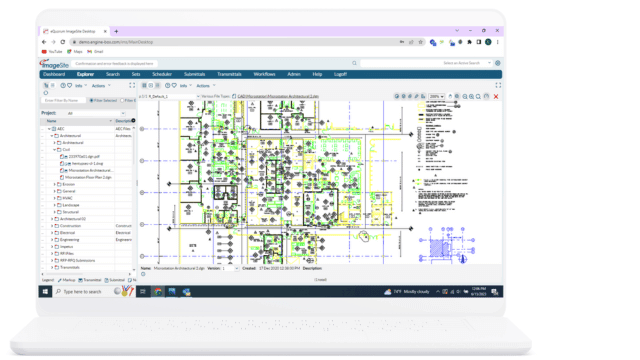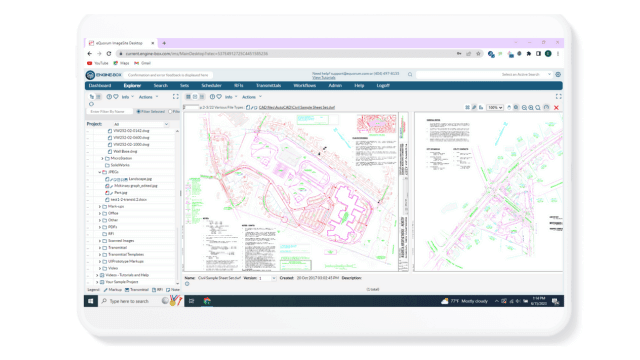Eliminate Data Silos and Improve Your Bottom Line
Eliminate Data Silos and Improve Your Bottom Line
When you hear the word silo, you may think of the tall standalone structures found in farms, typically used to store grain. However, the word “silo” actually carries a different, and broader meaning. Silo in verb form means to isolate (one system, process, or department) from others. Data silos (a situation where only a single group has access to a source of data at any given time) are far too common in the engineering world, as inefficient systems can make it difficult for organizations to access documents and document related data across teams and departments. Alas, we see evidence of data silos negatively affecting companies’ bottom lines, as they create a number of inefficiencies that increase time-to-market, and ultimately negatively impact ROI.
Data silos are often formed when project members are limited to specific tasks, based on the documents they can access at a given moment. Similar to bottlenecks, data silos prevent teams from continuing a project contingent on the completion of another workflow step. These are often seen in linear, task-centric workflows that inhibit workers from collaborating concurrently. Fortunately, silos are avoidable, as engineering managers can use software to construct more efficient silo-less workflows.

Eliminate Bottlenecks Through Engineering Workflow Management
Detect bottlenecks, rethink workflows and create more efficient processes with a workflow and document management system.
How do data silos affect ROI?
In the Architecture, Engineering, and Construction (AEC) industries, there is a multitude of steps companies must take before a project can reach completion. These steps are typically broken down into phases (e.g., Schematic Design, Construction Documents, Construction Administration, and Construction Support Services). Each major step typically must be completed in full before moving on to the next step of a construction project. If silos form throughout a step, the entire process can be delayed and create delays the company’s return on investment.
Ensuring quick return on investment is a top priority for owners, as it allows them to move on to other projects and secure more revenue. Depending on your company’s size and business model, freeing up employee time and resources can similarly allow for more projects and more revenues.
Eliminating data silos and improving your bottom line
Improving time-to-market and ROI takes careful planning, and the assistance of software automation to eliminate unnecessary tasks from employee workloads. While there is no one-size-fits-all solution to counteract data silos, there are a few practices that can keep silos them from occurring:
- Creating Fully-Integrated Document-Centric Workflows
- Automating Document Actions Using Workflow Software
- Allowing Multiple Reviewers to View and Edit Documents Concurrently
- Steering Clear of Sequential Workflows.
Due to the nature of some projects, it's sometimes impossible to avoid creating linear (sequential) workflows. You should, however, attempt to create an engineering workflow, if possible. While AEC companies have no choice but to break down large construction projects into phases, much of the smaller tasks can be worked on concurrently.

Engineering Workflow
Automatically manage and distribute files and documents for review, approval, and processing. Adjust user permissions at each step, ensuring your company’s files are managed securely.
Engineering workflow and document management software enables engineering managers to review and approve documents with multiple reviewers. Rather than arranging meetings and passing a document between many hands, companies can keep a drawing or document within a single source of truth (i.e., document management software), and provide notifications when it’s an employee’s time to take action.
ImageSite uses a canvas-like tool for designing and constructing workflows. With this tool, you can create workflows that deviate from their original path and trigger an additional review process that instantly sends the in-review documents to the appropriate reviewer. In the meantime, workers can access the documents found in the other portion of the workflow to improve productivity by allowing others to work on their portion of the project.
Additionally, employees often get bogged down with menial tasks pertaining to document management. Tasks such as deleting, moving, copying, archiving, and launching transmittals are some of the tasks that organizations can automate to reduce the time it takes to file documents and get to project completion faster.
Data silos can be tricky to manage, but if you can spot them, you can find ways to work around them. Data silos don’t always occur during the engineering design process, but can also occur throughout various other stages of a project. On-premise and Cloud workflow and document management solutions can help organizations keep communication flowing, and eliminate silos that lead to unnecessary project delays. Additionally, it can provide insights that help companies improve other processes and can ultimately lead to a more productive workforce.
Additional EDMS Features
Our EDMS solutions
ImageSite and EngineBox are eQuorum’s robust workflow and document management solutions, created to help workers manage their essential workflows while maintaining complete control over their engineering files and documents. Not only do they provide a secure collaboration site for workers, but they also help organizations manage document distribution with third parties like vendors, contractors, and customers. Both systems are offered at a competitive price, enabling organizations to get a quick return on their investment by providing the features and functionality needed to help organizations improve efficiency, productivity, and collaboration. Companies can choose from concurrent user subscriptions or named user subscriptions, ensuring organizations have subscription options that make sense for their business.

ImageSite®
Our single source engineering workflow and document management system. Built in HTML5 so there is no software to deploy to client computers or mobile apps to download. Offered as an On-premise or Private Cloud system.
EngineBox™
EngineBox is a cloud based workflow and document management version of ImageSite that resides outside the corporate network.
Our EDMS solutions
ImageSite and EngineBox are eQuorum’s robust workflow and document management solutions, created to help workers manage their essential workflows while maintaining complete control over their engineering files and documents. Not only do they provide a secure collaboration site for workers, but they also help organizations manage document distribution with third parties like vendors, contractors, and customers. Both systems are offered at a competitive price, enabling organizations to get a quick return on their investment by providing the features and functionality needed to help organizations improve efficiency, productivity, and collaboration. Companies can choose from concurrent user subscriptions or named user subscriptions, ensuring organizations have subscription options that make sense for their business.

EngineBox™
EngineBox is a cloud based workflow and document management version of ImageSite that resides outside the corporate network.
The eQuorum Customer Promise
In 2005, eQuorum developed the first all browser-based EDMS. The system, although for on-premise use, was still created to remove client software and JAVA from user computers and allow users to have a single viewer based on the simple navigation functionality of browsers. Today, eQuorum provides that same application in a private Cloud or a SaaS Cloud option. We can do this because we are, and have always been, browser-based, understanding the enhanced speed, security, and usability of this technology.
With the abundance of document management systems on the market today, there’s no doubt that choosing the right Cloud document management software can be a difficult decision. eQuorum is here to provide a comprehensive, powerful, and most importantly – affordable Cloud document management solution. We believe in providing real value to our customers by eliminating unnecessary costs, providing industry-leading functionality, and equipping your team with the right tools using cutting edge technology to bring your products to market faster.
eQuorum®
We specialize in engineering workflow and document management. Our comprehensive, yet easy-to-use software provides the solution to manage data from design to manufacturing and production, to sales, support and administration.